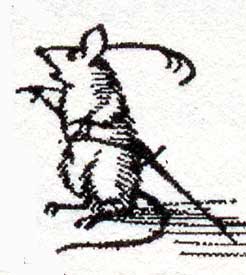Checking in on Narnia: The Voyage of The Dawn Treader This is not just because of technical animation deficiencies. In the recently released The Voyage of The Dawn Treader, most of the anthropomorphization budget went, with impressive results, toward Reepicheep the mouse; Aslan still appears as if he has been stripped into the film frames. My apprehension is also because no movies or books that conjure a world wherein mythical creatures, talking animals and human beings intermingle can be It's a Wonderful Life. The greatest stories treat of truths about the human condition. Even if the conjurer intends to depict said truths, his minotaurs and talking bears get in the way. Nevertheless I'm following the Narnia movies being made by Disney/Walden Productions simply because they are good stories, if not great ones. The notions suggested in them are seldom, if ever, expressed in popular culture. Probably because C.S. Lewis wrote spiritual works, it has gotten around that The Chronicles of Narnia contain some kind of "Christian message." For this reason, of course, the secular media's movie critics are hostile. Christianity, to them, is the only nonsense there is. They probably also fear that the series will inspire evangelical dittoheads to set upon and massacre gay people. I read several reviews of The Voyage of The Dawn Treader, the most positive of which declared that the movie was commendable "in spite of" (the assumed Christian message). Another accused the Disney makers of the Narnia series of pandering to "a perceived audience" and still another declared that Lucy and Edmund and their adventures are uninteresting because, as everybody knows, Aslan is going to see them safely home in the end. A fourth critic even thought of Eustace as comic relief and seemed to regret the changes that overcome the character. Well, of course, the untransformed Eustace, a middle-class suburban snot who has everything aplenty and never finds himself in "the most distressing circumstance" is the type who grows up to be a secular-media movie critic or otherwise a whiner about how horrible life is, especially on account of religion. As the pundits loathe the Narnia stories with prejudice, Christians invest too much significance in them. While there are Christian thoughts, visions, suggestions, if you will, in the stories, there are no messages. There is a difference between Christian artists who create works with Christian messages and Christian artists who create works as Christians. C.S. Lewis, like Flannery O'Connor, falls into the latter category. As a serious, thoughtful Christian, Lewis pondered such things as temptation, the supernatural, the deficiencies of a world that rejects God and traditional morality. Such thinking flowed into his work. However anyone, believer or heathen critic, who presumes or looks for a coherent syllabus, code or set of marching orders for Christian solders in the Oxford don's fantasies is going to be deluded or frustrated because such are simply not there. Lewis was also an afficionado of mythology and legend. The Voyage of The Dawn Treader indeed reminds one of Homer's Odyssey moreso than say, the missionary voyages of St. Paul. But what Christian visions that have seeped into Lewis's Narnia works are sophisticated and thought-provoking observations of the human condition. I hope that the movie makers don't attenuate or snap these by straying too far from the original stories. They tinkered with the plot in The Voyage of The Dawn Treader, adding a green mist and a business about seven swords. This suggests that there are symbols that must be deciphered. Granted, Dawn Treader is not the best book of the series; it was a vehicle for Lewis to introduce the disagreeable Eustace Scrubb. I think, too, that it satirizes the unruliness of demagogue-led lower classes or colonial subjects (Dufflepuds) in the absence of a nobility who have moral authority and who set moral example. It could be a political commentary on the author's homeland. Twentieth-Century Britain certainly fit the pattern and continues to do so as it embarks on another go-round with a prince and his chickey-boo. On film, Eustace's tenure as a dragon is portrayed as a condition that turns out to be really cool. In the book it is never cool that Eustace is a dragon. It is "the most distressing circumstance," a bout of suffering that inspires sympathy in Eustace's companions and makes him want to be a member of the human race instead of a competitive little proto-movie critic. Lucy's envy of and desire to be as beautiful as her older sister is well-played as an obvious danger that will distract her from more noble pursuits. In the book, it is written that Susan (the older sister) loses interest in Narnia in spite of her adventures there. This is hardly grounds for the detractors' charge of "predictability." I hope that in adapting and filming The Silver Chair, the Disney/Walden people follow the first page of the book very faithfully. Anyone who looks askance at theories now in full bloom in public education and child-rearing will understand why. |
 |
|---|
Copyright 2010 by Neal J. Conway. All rights reserved.